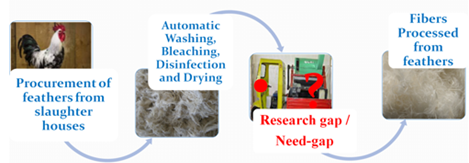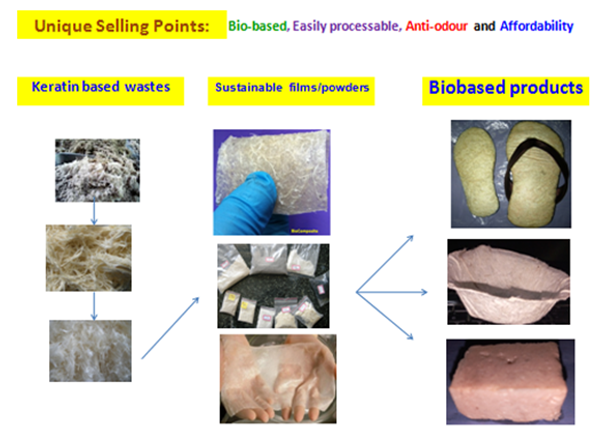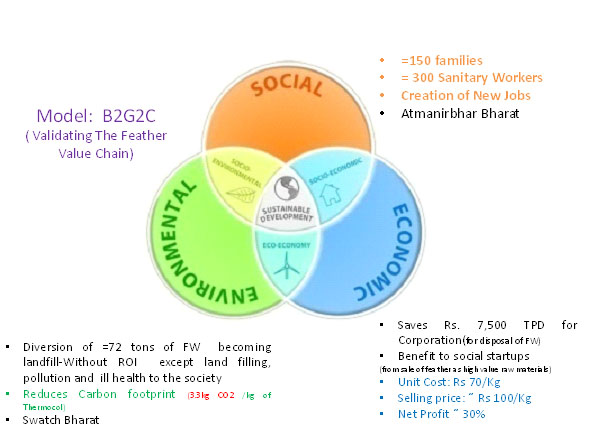Description
Abstract: Chicken feather waste poses significant environmental concerns, with India generating over 3.5 million tons annually The poultry industry generates millions of tons of chicken feather waste annually, posing significant environmental concerns. This case review examines innovative sustainable waste management solutions, highlighting best practices, challenges, and opportunities for improvement. Through a comprehensive analysis of existing literature and industry case studies, this review provides valuable insights for stakeholders seeking to adopt environmentally friendly practices.
Introduction
The poultry industry generates millions of tons of chicken feather waste annually, posing significant environmental concerns. In India alone, over 3.5 million tons of feather waste is produced every year (Dhoolappa et al., 2016). If not managed properly, this waste can contaminate water sources, soil, and air, harming human health and the ecosystem. Historically, feather waste has been disposed of through land filling, incineration, or composting, but these methods have limitations and drawbacks. Recycling and up cycling feather waste into value-added products offer a sustainable solution (Srinath et al., 2022. This approach not only reduces waste disposal costs but also creates new revenue streams, job opportunities, and contributes to a circular economy (Dhoolappa et al., 2023). This review article explores the potential of recycling chicken feather waste into valuable products, highlighting its environmental and societal benefits. By adopting innovative technologies and strategies, we can transform a significant waste management challenge into an economic and environmental opportunity.
II. Current Challenges and Opportunities: The existing feather waste management practices face significant challenges, making recycling and upcycling essential.
Current Challenges:
1. Inefficient disposal methods (landfilling, incineration, composting)
2. Environmental concerns (water pollution, soil contamination, greenhouse gas emissions)
3. Economic constraints (high disposal costs, low value of feather waste)
4. Lack of regulations and standards for feather waste management
5. Limited public awareness and education
Fig 1: Schematic diagram depicting research need gap in Chicken Feather Waste Management
Emerging Opportunities:
1. Circular economy approaches
2. Biorefineries and biotechnology
3. Value-added product development (feather meal, keratin-based products)
4. Renewable energy generation (biofuels, biogas)
5. Closed-loop production systems
Technological Advancements:
1. Hydrolysis and enzymatic treatment
2. Microbial fermentation and biodegradation
3. Nanotechnology and material science
4. Advanced separation and purification techniques
Regulatory Frameworks:
1. Government incentives for sustainable waste management
2. Extended Producer Responsibility (EPR) policies
3. Waste-to-Wealth initiatives
4. International collaborations and knowledge sharing
By addressing current challenges and leveraging emerging opportunities, the poultry industry can transition towards a more sustainable and environmentally friendly feather waste management system.
III. Initiatives on Value-Added Products from Chicken Feather Waste
Chicken feather waste is being transformed into various value-added products, yielding economic and environmental benefits. Advanced production processes and technologies, including:
- Emerging technologies (nanotechnology, biotechnology)
Enable the conversion of feather waste into:
- Keratin-based cosmetics and pharmaceuticals
- Biodegradable plastics
- Animal feed supplements
- Organic fertilizers
- Textiles
Successful pilot-scale implementations have been achieved by:
- Adisseo (France)
- Evonik (Germany)
- Darling Ingredients (USA)
- VCS (Veterinary College, Shivamogga, /KVAFSU (Karnataka Veterinary, Animal and Fisheries Sciences University, Karnataka, India)
Fig.2: Few Value-Added Products from Chicken Feather Waste
IV. Case Studies and Success Stories: Real-world examples demonstrate the effectiveness of chicken feather waste recycling.
Case Study: ESRAG/Rotary Clubs Feather Waste Recycling Initiative
Objective: To reduce greenhouse gas emissions and create employment opportunities through feather waste recycling and keratin-based product development.
Outcomes:
1. 70% reduction in GHG emissions: ESRAG/Rotary clubs' feather waste recycling efforts led to a significant decrease in greenhouse gas emissions.
2. New jobs created: Keratin-based product development under VCS, KVAFSU's technical guidance generated employment opportunities for local communities.
3. Improved waste management: The initiative diverted feather waste from landfills, reducing waste disposal costs and mitigating environmental pollution.
4. Enhanced community engagement: The project raised awareness about sustainable waste management practices and promoted community involvement.
Key Strategies:
1. Technical mentorship: VCS, KVAFSU provided expertise in feather waste recycling and keratin-based product development.
2. Community outreach: ESRAG/Rotary clubs engaged local stakeholders, ensuring broad participation and support.
3. Innovative product development: Keratin-based products (e.g., cosmetics, fertilizers) created new revenue streams.
Lessons Learned:
1. Collaborative approach: Partnerships between NGOs, academia, and local communities can drive sustainable change.
2. Technical expertise: Mentorship from specialized institutions (VCS, KVAFSU) ensured project success.
3. Innovative thinking: Keratin-based product development opened new economic opportunities.
Research Institution: Biodegradable Plastics
- Institution: KVAFSU
- Location: Karnataka
- Product: Biodegradable plastics from feather waste
- Impact: Developed patented technology, reduced plastic waste by 40%
These success stories showcase the potential of chicken feather waste recycling.
Replicability:
This case study demonstrates the potential for feather waste recycling and keratin-based product development to create environmental, social, and economic benefits. The model can be replicated in other regions, promoting sustainable waste management practices and community development.
Impact:
Outcome:
. For every one ton of feather recycled, it will replace polystyrene 1:1
. Thereby, the segregated feather waste in the urban areas is contributing to saving an average of 0.20 tons per from becoming land fill. In addition, lowering greenhouse gases (GHG) emissions and diversion of waste from the landfill further increased the positive impact on the environment.
. The implementation statistics also show that for every 250 kgs of wet waste segregated, ONE job is created.
. This project will impact more than 150 families and 100 sanitary workers to improve their health, as well as to maintain hygienic condition of the shimoga city, Karnataka, India.
Future Research Directions
1. Scalability: Scaling up novel biodegradable plastics for industrial applications.
2. Optimization: Optimizing conditions for bio composite preparation.
3. Product Development: Developing new value-added products from chicken feather waste.
4. Policy Frameworks: Establishing policy frameworks to support sustainable chicken feather waste management practices.
This case review highlights the importance of sustainable chicken feather waste management in the poultry industry. By adopting innovative solutions and best practices, stakeholders can reduce environmental harm, promote a circular economy, and create new revenue streams. Finally, circular economy initiatives will integrate chicken feather waste into existing waste management systems, explore synergies with other waste streams, and develop closed-loop production systems and innovative business models.
References:
Dhoolappa, M. Veerannagouda B.G., Lakshmishree K.T., & GangaNaik S
Veterinary College, Shivamogga – 577204;
Karnataka Veterinary, Animal and Fisheries Sciences University
Introduction
The poultry industry generates millions of tons of chicken feather waste annually, posing significant environmental concerns. In India alone, over 3.5 million tons of feather waste is produced every year (Dhoolappa et al., 2016). If not managed properly, this waste can contaminate water sources, soil, and air, harming human health and the ecosystem. Historically, feather waste has been disposed of through land filling, incineration, or composting, but these methods have limitations and drawbacks. Recycling and up cycling feather waste into value-added products offer a sustainable solution (Srinath et al., 2022. This approach not only reduces waste disposal costs but also creates new revenue streams, job opportunities, and contributes to a circular economy (Dhoolappa et al., 2023). This review article explores the potential of recycling chicken feather waste into valuable products, highlighting its environmental and societal benefits. By adopting innovative technologies and strategies, we can transform a significant waste management challenge into an economic and environmental opportunity.
II. Current Challenges and Opportunities: The existing feather waste management practices face significant challenges, making recycling and upcycling essential.
Current Challenges:
1. Inefficient disposal methods (landfilling, incineration, composting)
2. Environmental concerns (water pollution, soil contamination, greenhouse gas emissions)
3. Economic constraints (high disposal costs, low value of feather waste)
4. Lack of regulations and standards for feather waste management
5. Limited public awareness and education
Fig 1: Schematic diagram depicting research need gap in Chicken Feather Waste Management
Emerging Opportunities:
1. Circular economy approaches
2. Biorefineries and biotechnology
3. Value-added product development (feather meal, keratin-based products)
4. Renewable energy generation (biofuels, biogas)
5. Closed-loop production systems
Technological Advancements:
1. Hydrolysis and enzymatic treatment
2. Microbial fermentation and biodegradation
3. Nanotechnology and material science
4. Advanced separation and purification techniques
Regulatory Frameworks:
1. Government incentives for sustainable waste management
2. Extended Producer Responsibility (EPR) policies
3. Waste-to-Wealth initiatives
4. International collaborations and knowledge sharing
By addressing current challenges and leveraging emerging opportunities, the poultry industry can transition towards a more sustainable and environmentally friendly feather waste management system.
III. Initiatives on Value-Added Products from Chicken Feather Waste
Chicken feather waste is being transformed into various value-added products, yielding economic and environmental benefits. Advanced production processes and technologies, including:
- Emerging technologies (nanotechnology, biotechnology)
Enable the conversion of feather waste into:
- Keratin-based cosmetics and pharmaceuticals
- Biodegradable plastics
- Animal feed supplements
- Organic fertilizers
- Textiles
Successful pilot-scale implementations have been achieved by:
- Adisseo (France)
- Evonik (Germany)
- Darling Ingredients (USA)
- VCS (Veterinary College, Shivamogga, /KVAFSU (Karnataka Veterinary, Animal and Fisheries Sciences University, Karnataka, India)
Fig.2: Few Value-Added Products from Chicken Feather Waste
IV. Case Studies and Success Stories: Real-world examples demonstrate the effectiveness of chicken feather waste recycling.
Case Study: ESRAG/Rotary Clubs Feather Waste Recycling Initiative
Objective: To reduce greenhouse gas emissions and create employment opportunities through feather waste recycling and keratin-based product development.
Outcomes:
1. 70% reduction in GHG emissions: ESRAG/Rotary clubs' feather waste recycling efforts led to a significant decrease in greenhouse gas emissions.
2. New jobs created: Keratin-based product development under VCS, KVAFSU's technical guidance generated employment opportunities for local communities.
3. Improved waste management: The initiative diverted feather waste from landfills, reducing waste disposal costs and mitigating environmental pollution.
4. Enhanced community engagement: The project raised awareness about sustainable waste management practices and promoted community involvement.
Key Strategies:
1. Technical mentorship: VCS, KVAFSU provided expertise in feather waste recycling and keratin-based product development.
2. Community outreach: ESRAG/Rotary clubs engaged local stakeholders, ensuring broad participation and support.
3. Innovative product development: Keratin-based products (e.g., cosmetics, fertilizers) created new revenue streams.
Lessons Learned:
1. Collaborative approach: Partnerships between NGOs, academia, and local communities can drive sustainable change.
2. Technical expertise: Mentorship from specialized institutions (VCS, KVAFSU) ensured project success.
3. Innovative thinking: Keratin-based product development opened new economic opportunities.
Research Institution: Biodegradable Plastics
- Institution: KVAFSU
- Location: Karnataka
- Product: Biodegradable plastics from feather waste
- Impact: Developed patented technology, reduced plastic waste by 40%
These success stories showcase the potential of chicken feather waste recycling.
Replicability:
This case study demonstrates the potential for feather waste recycling and keratin-based product development to create environmental, social, and economic benefits. The model can be replicated in other regions, promoting sustainable waste management practices and community development.
Impact:
Outcome:
. For every one ton of feather recycled, it will replace polystyrene 1:1
. Thereby, the segregated feather waste in the urban areas is contributing to saving an average of 0.20 tons per from becoming land fill. In addition, lowering greenhouse gases (GHG) emissions and diversion of waste from the landfill further increased the positive impact on the environment.
. The implementation statistics also show that for every 250 kgs of wet waste segregated, ONE job is created.
. This project will impact more than 150 families and 100 sanitary workers to improve their health, as well as to maintain hygienic condition of the shimoga city, Karnataka, India.
Future Research Directions
1. Scalability: Scaling up novel biodegradable plastics for industrial applications.
2. Optimization: Optimizing conditions for bio composite preparation.
3. Product Development: Developing new value-added products from chicken feather waste.
4. Policy Frameworks: Establishing policy frameworks to support sustainable chicken feather waste management practices.
This case review highlights the importance of sustainable chicken feather waste management in the poultry industry. By adopting innovative solutions and best practices, stakeholders can reduce environmental harm, promote a circular economy, and create new revenue streams. Finally, circular economy initiatives will integrate chicken feather waste into existing waste management systems, explore synergies with other waste streams, and develop closed-loop production systems and innovative business models.
References:
- Dhoolappa M., Prasad R.V., Jamuna K.V., Narayana swamy H.D., Nagaraj B. N., Chandrashekar Murthy V., Nagappa K., Lakshmishree K.T. and Mahadevprasad C.B. 2016. Natural and Economic Biodegradation of Poultry Feather Waste. Veterinary Research International 4 (1): 50-53.
- Srinath, RD Prasad, RV Dhoolappa, M. Girish MH and Girish Kumar, V. 2022. Hybrid polymer film preparation as a scaffold for tissue engineering and its mechanical strength. The Pharma Innovation Journal 2022; SP-11(5): 1228-1231
- Dhoolappa M, Lakshmishree K.T., Sundareshan Sand Prasad R.V. 2023. Bio composites from chicken feather waste. Resources, recycling, and waste management. 8(1):1-6.
- The Patent Office Journal No. 17/2018 Dated 27/04/2018; Sustainable Bioproducts From Keratin Based Materials For Multiple Applications and Method of Their Processing (Application No.: 201641036418) By Dhoolappa Melinamani and R.V. Prasad
Dhoolappa, M. Veerannagouda B.G., Lakshmishree K.T., & GangaNaik S
Veterinary College, Shivamogga – 577204;
Karnataka Veterinary, Animal and Fisheries Sciences University
Open Access
Filling the gap between research and communication ARCC provide Open Access of all journals which empower research community in all the ways which is accessible to all.
Products and Services
We provide prime quality of services to assist you select right product of your requirement.
Support and Policies
Finest policies are designed to ensure world class support to our authors, members and readers. Our efficient team provides best possible support for you.
Follow us


